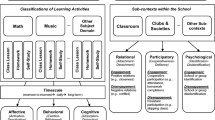Abstract
Research on public education often concludes that low achievement is partly caused by a lack of student commitment to an educational goal. This study investigates the sense of academic purpose among students in a private secondary school where all graduates go to college, and explores the mechanisms of student commitment built into the social organization of the school. Results show that educational commitment among students develops from intensive face-to-face interaction in a primary community, the sense of history and tradition resulting from continuity in students' educational experiences, and the substantial power students have over their own school lives. These results add qualitative information to the debate over differences between public and private education, and suggest ways to improve public schools.
Similar content being viewed by others
References
Barker, Roger G. and Paul C. Gump 1964 Big School, Small School. Stanford: Stanford University Press
Buber, Martin 1961 Between Man and Man (R.G. Smith, Trans.). London: Fontana Library.
Coleman, J.S. 1959 “Academic achievement and the structure of competition.” Harvard Educational Review 29:330–351.
Coleman, James S. 1961 The Adolescent Society. New York: Free Press.
Coleman, James S., Thomas Hoffer and Sally Kilgore 1981 “Public and private schools.” Final Report for the National Center for Education Statistics. Submitted by the National Opinion Research Center, The University of Chicago.
Colson, E. 1974 Tradition and Contract: The Problem of Order. Chicago: Aldine.
Cusick, Philip A. 1973 Inside High School: The Student's World. New York: Holt, Rinehart and Winston.
The Eight Year Study 1943 Adventures in American Education: Thirty Schools Tell Their Story. New York: Harper Brothers.
Geertz, Clifford 1973 The Interpretation of Cultures. New York: Basic Books.
Grant, G. 1981 “The character of education and the education of character.” Daedalus 110:135–149.
Hansell, Stephen 1981 “Ego development and peer friendship networks.” Sociology of Education 54:51–63.
Hansell, Stephen 1982 “Student, parent, and school effects on the stress of college application.” Journal of Health and Social Behavior, 23:38–51.
Homans, George C. 1974 Social Behavior: Its Elementary Forms. New York: Harcourt, Brace and Jovanovich.
Jackson, Philip W. 1968 Life in Classrooms. New York: Holt, Rinehart and Winston.
Kraushaar, Otto F. 1972 American Nonpublic Schools. Baltimore: Johns Hopkins University Press.
Nehrt, Roy C. 1981 Private Schools in American Education. National Center for Educational Statistics.
Page, Ellis B. and Timothy Z. Keith 1981 “Effects of U.S. private schools: A technical analysis of two recent claims.” Educational Researcher 10:7–17.
Schroder, H.M., and M.J. Driver and S. Streufort 1967 Human Information Processing. New York: Holt, Rinehart and Winston.
Strodtbeck, Fred L. 1965 “The hidden curriculum in the middle-class home.” In L.D. Krumboltz (ed.) Learning and the Educational Process. Chicago: Rand McNally.
Author information
Authors and Affiliations
Additional information
The writing of this article was partly supported by National Institute of Education Grant NIE-G-80-0113 made to the Center for Social Organization of Schools at John Hopkins University. The opinions expressed do not necessarily represent the position or policy of the Institute, and no official endorsement should be inferred. The author would like to thank anonymous reviewers for helpful comments.
Rights and permissions
About this article
Cite this article
Hansell, S. Student commitment and purpose in a private secondary school. Qual Sociol 6, 163–181 (1983). https://doi.org/10.1007/BF00987086
Issue Date:
DOI: https://doi.org/10.1007/BF00987086




